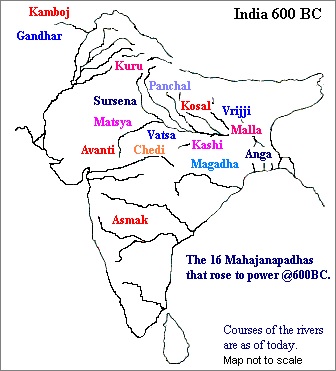Mahajanapadas and Rise of Magadha
by Devender
0 2041
Buddhist literature "Angutara Nikaya" gives information on 16 great kingdoms or Mahajanapadas at the beginning of the 6th century BC. The major reason for the formation of these janapads was the use of iron for agricultural and military purposes.
Mahajanapadas
Over time, small or weak kingdoms submitted to stronger rulers/kingdoms and got eliminated. In the 6th century BC, only 4 major janapadas remained: Vatsa, Avanti, Magadha, and Kosala.
- Vatsa:
- Avanti:
- Kosala:
- Magadha:
- Mahajanapadas and their capitals:
It shifted the Kuru clan with its capital at Kaushambi. Udayana was the most powerful leader of Vatsa and after his death, it was annexed to Avanti.
The most important ruler of Avanti was Pradyota. They patronized Buddhism and later got annexed to Magadha.
Its most powerful ruler was Prasenjit whose sister was married to Bimbisara. He gave Kashi as dowry to Magadha and after his death, Kosala became a part of Magadha.
Magadha was the most powerful kingdom of North India and it was founded by Jarasangha. Its most powerful rulers were: Bimbisara, Ajatashatru (Haryankas), Shishunaga, and Nandas.

| Mahajanapadas | Capital |
| Kamboja | Rajpura |
| Gandhar | Taxila |
| Surasena | Mathura |
| Matsya | Virat |
| Vatsa | Kaushambi |
| Chedis | Shuktimati |
| Kasi | Varanasi |
| Avanti | Ujjain & Mahismati |
| Kuru | Hatinapur & Indraprastha |
| Panchala | Kampilya & Ahichattra |
| Kosala | Ayodhya & Sravasti |
| Mallas | Pava & Kusinagar |
| Vajjis | Vaishali |
| Anga | Champa |
| Magadha | Rajgir |
| Asmaka | Potana |
Rise of Magadha
- Bimbisara:
- Ajatashatru:
- Udayin:
- Shishunagas:
- Mahapadmananda:
- Dhanananda:
- Cause of success of Magadha:
- Magadha had an advantageous geographical position and rich iron ores of Rajgir
- Magadha's capital Rajgir was surrounded by 5 hills and the other one Patliputra was surrounded by Ganga, Gandhak, Son & Ghagra river
- Magadha was the first one that started using elephants in war
He was contemporary to both Jainism and Buddhism and set up his capital at Rajgir. He strengthened his position with various marriage alliances. He acquired Anga under the viceroyalty of Ajatashatru and fought with Pradyota of Avanti but eventually, became his friend.
He killed his father and became king. He fought with Kosala & Vaishali and won both wars. He embraced Buddhism at last and led the foundation of the first Buddhist council at Rajgir.
He was the successor of Ajatashatru. He was the one who made Patliputra new capital. His death ended the Haryanaka dynasty.
He temporarily shifted the capital to Vaishali. He was able to Avanti, bringing an end to 100 years old rivalry. Later, he transferred the capital back to Patliputra.
He was known as Ekarat which means sole king who destroys others. He conquered Kalinga and brought the image of Jina as a trophy. The Hathigumpha inscription of kharavela King (Kalinga) refers to the conquest of Kalinga by Nandas.
He was the last ruler of the Nanda dynasty and in his reign, Alexander invaded India but did not move to the powers of Nanda. He was overthrown by Chandragupta Maurya & Kautilya as his oppressive way of collecting taxes was already resented by people.

Share:







Comments
Waiting for your comments